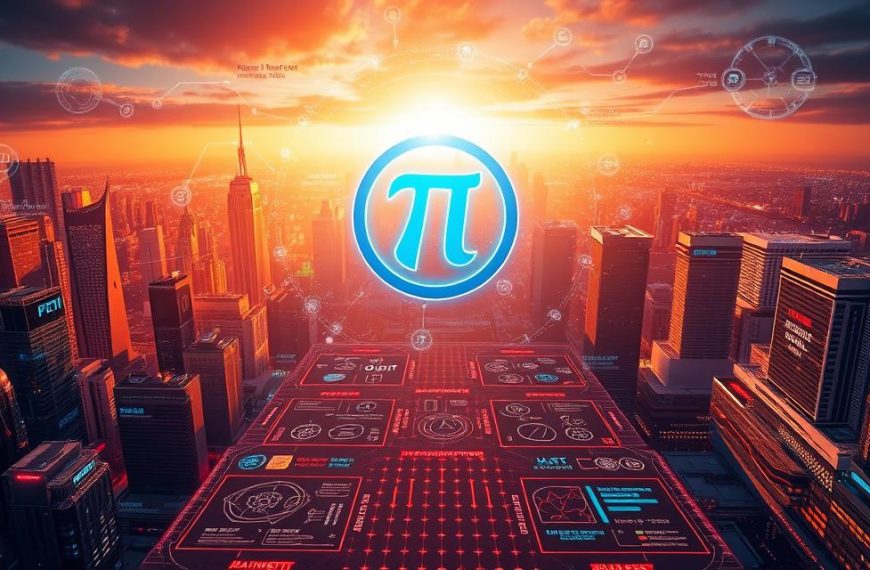Digital currencies operate without central authorities like banks or governments. These systems rely on blockchain technology, a distributed ledger that records transactions across a vast network. This setup ensures transparency and security, making it a game-changer in the financial world.
Bitcoin and Ethereum are prime examples of this innovation. Bitcoin’s network spans over 15,000 nodes, while Ethereum’s global validator network ensures seamless operations. These platforms highlight the real-world relevance of decentralization in modern finance.
Traditional banking systems often face risks like data breaches or institutional collapses. In contrast, decentralized systems reduce fraud risk and offer 24/7 global access. Transactions are censorship-resistant, providing users with unparalleled freedom and security.
Since 2020, the adoption of such systems by financial institutions has surged. The Bitcoin Whitepaper’s vision of eliminating trusted third parties is now more relevant than ever. This shift marks a significant step toward a more secure and inclusive financial future.
Introduction to Decentralized Cryptocurrency
Blockchain networks redefine how financial systems operate by eliminating single points of failure. Unlike traditional models, these systems distribute control across a vast network, ensuring resilience and transparency. This approach minimizes risks associated with centralized entities.
Defining Decentralized Cryptocurrency
Imagine a warehouse system. A centralized model relies on a single company-owned facility. A distributed model uses multiple warehouses owned by one entity. In contrast, a decentralized system operates like 1,000 independent warehouses, each managed by different owners. This structure ensures no single point of failure.
In the context of blockchain technology, this means transactions are verified by a network of nodes rather than a central authority. Bitcoin’s network, for example, spans over 15,000 nodes globally, ensuring data integrity and security.
Why Decentralization Matters in Cryptocurrency
Decentralization prevents single-entity control, a critical issue in traditional systems. For instance, in 2017, Bitmain’s Antbleed backdoor incident highlighted vulnerabilities in centralized mining operations. Decentralized networks mitigate such risks by distributing control across multiple participants.
Another key advantage is trust minimization. Cryptographic proofs replace reliance on institutions, ensuring transactions are secure and transparent. Unlike banks, which can reverse transactions, blockchain records are immutable, providing users with unparalleled security.
| Feature | Centralized Systems | Decentralized Systems |
|---|---|---|
| Control | Single entity | Distributed network |
| Trust Model | Institutional reliance | Cryptographic proofs |
| Transaction Reversal | Possible | Impossible |
How Decentralized Cryptocurrency Works
The backbone of modern digital finance lies in its innovative systems. These systems rely on blockchain technology to ensure secure and transparent operations. By distributing control across a vast network, they eliminate single points of failure and enhance resilience.

The Role of Blockchain Technology
Blockchain serves as the foundation for decentralized systems. It records transactions in blocks, which are linked together to form a chain. Each block contains a unique cryptographic hash, ensuring data integrity. This process makes tampering nearly impossible.
Bitcoin’s network, for example, performs 500 quintillion hash guesses per second. This immense computational power ensures the system’s security. Ethereum, on the other hand, requires validators to stake a minimum of 32 ETH, adding another layer of trust to the network.
Understanding Network Nodes
Nodes are critical components of any decentralized system. They validate and relay transactions, ensuring the network operates smoothly. There are two main types: full nodes and mining/staking nodes.
Full nodes store the entire blockchain, verifying all transactions. Mining or staking nodes, however, focus on adding new blocks to the chain. Bitcoin’s 10-minute block time contrasts with Ethereum’s 12-second slots, showcasing the diversity in network operations.
Hardware requirements also vary. Bitcoin miners often use ASIC machines, while Ethereum validators can operate with consumer-grade setups. This flexibility ensures broader participation in maintaining the network.
Security remains a top priority. Bitcoin’s 51% attack prevention mechanisms highlight the robustness of decentralized systems. A March 2023 NYTimes report emphasized the growing concentration of U.S. mining, underscoring the need for continued vigilance.
Key Features of Decentralized Cryptocurrency
Modern financial systems are evolving with innovative technologies that prioritize user control and transparency. These advancements ensure that transactions are secure, verifiable, and resistant to tampering. By leveraging blockchain technology, these systems offer features that redefine trust and security in finance.
Immutability and Transparency
One of the standout features of blockchain is its immutability. Once a transaction is recorded, it cannot be altered. This is achieved through cryptographic hashing, which ensures data integrity. Each block contains a unique hash, making tampering nearly impossible.
Public ledgers further enhance transparency. Unlike traditional financial systems, where records are often opaque, blockchain allows anyone to verify transactions. This openness fosters trust and accountability across the network.
Security and Trust Minimization
Security is a cornerstone of decentralized systems. Ethereum’s slashing mechanisms penalize validators for misconduct, ensuring the network remains reliable. This approach minimizes the need for trust in centralized entities.
Multi-signature wallets add another layer of security. These wallets require multiple approvals for transactions, reducing the risk of unauthorized access. This feature empowers users with greater control over their assets.
However, challenges like wealth concentration persist. For instance, Bitcoin’s top 100 addresses hold 13.52% of its supply, while Ethereum’s figure stands at 35.13%. Addressing these disparities is crucial for maintaining network decentralization.
Benefits of Decentralized Cryptocurrency
Decentralized systems offer transformative benefits that challenge traditional financial models. By eliminating centralized control, these systems empower users with greater autonomy and security. Additionally, they significantly reduce transaction costs, making financial services more accessible globally.

Elimination of Centralized Control
Traditional financial systems rely on centralized entities like banks, which can be prone to failures or misuse. Decentralized networks distribute control across a vast network, ensuring no single point of failure. This structure enhances resilience and transparency, making it a reliable alternative.
For example, Bitcoin’s global node network ensures that no single entity can manipulate the system. This approach minimizes risks like fraud or censorship, providing users with unparalleled freedom. Such autonomy is particularly valuable in regions with unstable financial institutions.
Reduced Transaction Costs
One of the most significant benefits is the reduction in transaction costs. Traditional remittance services like Western Union charge 5-10% fees, while Bitcoin averages less than 1%. This cost efficiency makes cross-border payments more affordable and accessible.
Ethereum’s Merge further highlights this advantage by reducing energy consumption by 99.95%. Such innovations not only lower costs but also make the process more sustainable. Smart contracts also eliminate the need for intermediaries like notaries, saving users additional fees.
Key advantages include:
- 24/7 availability, unlike traditional banking hours.
- Hyperinflation hedge, as seen in Venezuela’s adoption of Bitcoin.
- Access to DeFi for unbanked populations, per World Bank data.
These features collectively redefine how financial services operate, offering a more inclusive and efficient alternative to traditional models.
Examples of Decentralized Cryptocurrencies
Innovative financial systems have reshaped global economies by leveraging advanced technologies. Among these, Bitcoin and Ethereum stand out as pioneers, each offering unique features and applications. Their success highlights the potential of decentralized systems to revolutionize finance.

Bitcoin: The Pioneer of Decentralization
Bitcoin, launched in 2009, introduced the concept of a decentralized bitcoin network. Its proof-of-work mechanism ensures secure and transparent transactions. Over time, Bitcoin has evolved, with block rewards decreasing from 50 BTC to 3.125 post-2024 halving.
The system processes 144 blocks daily, ensuring steady transaction throughput. Its simplicity and security have made it a global standard for digital currencies. However, concerns about energy consumption persist, driving innovations in greener alternatives.
Ethereum and Smart Contracts
Ethereum revolutionized the ethereum blockchain by introducing smart contracts. These self-executing agreements enable complex applications like decentralized finance (DeFi) and non-fungible tokens (NFTs). Ethereum’s shift from proof-of-work to proof-of-stake in 2022 reduced its environmental impact by 99.95%.
With 7,200 blocks processed daily, Ethereum’s technology supports a wide range of transactions. However, centralization risks remain, as entities like Lido DAO control 32% of staked ETH. Decentralized staking pools like Rocket Pool offer alternatives to mitigate these risks.
| Feature | Bitcoin | Ethereum |
|---|---|---|
| Block Time | 10 minutes | 12 seconds |
| Consensus Mechanism | Proof-of-Work | Proof-of-Stake |
| Smart Contracts | No | Yes |
| Daily Blocks | 144 | 7,200 |
Real-world applications like Chainlink’s oracles and Uniswap’s decentralized exchange showcase the versatility of these platforms. Governance models in DAOs like MakerDAO and Compound further highlight the potential of decentralized systems.
“Decentralization is not just a feature; it’s a philosophy that empowers users and reshapes trust in financial systems.”
As these platforms evolve, addressing challenges like scalability and centralization will be crucial. The future of decentralized finance depends on balancing innovation with inclusivity.
The Process of Decentralized Transactions
The mechanics behind decentralized systems redefine how value is transferred globally. Unlike traditional methods, these systems rely on a network of participants to validate and record transactions. This approach ensures transparency, security, and efficiency, making it a cornerstone of modern finance.

Peer-to-Peer Transactions Explained
In a decentralized system, transactions occur directly between users without intermediaries. This peer-to-peer model eliminates the need for banks or payment processors. For example, Bitcoin’s process allows users to send funds with just three clicks, compared to the lengthy forms required for traditional wire transfers.
Once initiated, a transaction enters the mempool, where it competes for inclusion in the next block. Users can adjust fees to prioritize their transactions, creating a dynamic fee market. This flexibility ensures faster confirmations during high network activity.
How Consensus Mechanisms Work
Consensus mechanisms are the backbone of decentralized systems, ensuring all participants agree on the state of the blockchain. Bitcoin uses proof-of-work (PoW), where miners solve complex puzzles to validate transactions. This process takes about 10 minutes per block.
Ethereum, on the other hand, employs proof-of-stake (PoS), where validators stake tokens to participate. This method reduces energy consumption and achieves finality in just 12 seconds. Other variants like delegated proof-of-stake (DPoS) and proof-of-authority (PoA) offer unique trade-offs in security and efficiency.
Finality also varies across systems. Bitcoin’s probabilistic finality means older blocks are harder to reverse, while Ethereum’s absolute finality ensures immediate irreversibility. These differences highlight the diversity in decentralized network designs.
Preventing double-spending is another critical aspect. In PoW systems, chain reorganization costs make attacks economically unfeasible. For instance, GHash.io’s 2014 51% hash rate control raised concerns, but the majority of the group quickly addressed the issue, reinforcing the system’s resilience.
Decentralized Cryptocurrency vs. Traditional Financial Systems
The evolution of financial systems has introduced a new paradigm, challenging traditional models with innovative solutions. Decentralized systems, powered by blockchain technology, offer a stark contrast to conventional banking. This section explores the key differences and advantages of these two approaches.
Comparing Centralized and Decentralized Models
Traditional financial institutions rely on centralized control, where a single entity manages the system. This model often leads to inefficiencies, such as 72-hour ACH delays, and high operational costs. For example, JPMorgan’s 2021 IT budget exceeded $12 billion, reflecting the expenses of maintaining such a network.
In contrast, decentralized systems operate without intermediaries. Bitcoin’s organic network growth eliminates the need for costly infrastructure. Transactions are verified by a distributed network of nodes, ensuring near-instant settlements. This approach reduces reliance on centralized control and enhances transparency.
Advantages Over Traditional Banking
Decentralized systems offer several benefits over traditional banking. One key advantage is the elimination of intermediaries, which lowers transaction costs. For instance, Bitcoin’s average fee is less than 1%, compared to traditional remittance services that charge 5-10%.
Another benefit is the ability to bypass capital controls. In countries like China, where financial services are heavily regulated, Bitcoin provides permissionless access to global markets. This feature empowers individuals with greater financial freedom.
Decentralized systems also address risks associated with traditional banking. Unlike FDIC-insured accounts, which rely on government guarantees, decentralized systems promote self-custody. This reduces balance sheet risks and enhances user trust.
“Decentralization shifts the power from institutions to individuals, creating a more inclusive financial ecosystem.”
Operational efficiency is another area where decentralized systems excel. Traditional banks require physical branches, which incur high overhead costs. In contrast, decentralized systems rely on node operations, which are more cost-effective and scalable.
Finally, decentralized systems offer innovative solutions like collateralized DeFi lending, eliminating the need for credit scoring. This approach democratizes access to financial services, particularly for unbanked populations.
Challenges and Risks of Decentralized Cryptocurrency
While decentralized systems offer numerous advantages, they also face significant challenges that need addressing. From scalability limitations to regulatory hurdles, these issues highlight the complexities of modern financial innovations.
Scalability Issues
One of the most pressing challenges is scalability. Bitcoin’s network processes only 7 transactions per second (TPS), compared to Visa’s 24,000 TPS. This limitation can lead to slower transactions and higher fees during peak times.
Layer solutions like the Lightning Network and Polygon zkEVM aim to address these issues. The Lightning Network enables off-chain transactions, reducing congestion on the main network. Polygon zkEVM, on the other hand, uses zero-knowledge proofs to enhance throughput while maintaining security.
Another concern is Miner Extractable Value (MEV), where miners can exploit their position to prioritize certain transactions. This practice undermines the fairness of the network and poses risks to user data.
Regulatory Concerns
Regulatory challenges also loom large. In 2023, the SEC took action against major companies like Coinbase and Binance, citing compliance issues. These actions highlight the ongoing tension between innovation and regulation.
Jurisdictional conflicts further complicate matters. For example, the EU’s MiCA framework contrasts with varying state-level regulations in the U.S. This lack of uniformity creates uncertainty for companies and users alike.
Privacy tradeoffs are another critical issue. The sanctions on Tornado Cash, a privacy-focused application, underscore the challenges of balancing anonymity with regulatory compliance. Such measures can limit the services available to users.
Key challenges include:
- Energy consumption: Bitcoin’s 150 TWh/year usage sparks debates on sustainability.
- Quantum computing: Threats to ECDSA cryptography could compromise security.
- Wealth concentration: A small majority controls a significant portion of assets, raising concerns about control.
Addressing these challenges is crucial for the future of decentralized systems. Balancing innovation with security and compliance will ensure these technologies remain viable and inclusive.
The Future of Decentralized Cryptocurrency
The financial landscape is undergoing a transformative shift, driven by advancements in blockchain and decentralized systems. These innovations promise to redefine how global finance operates, offering new opportunities and challenges.
Emerging Trends and Innovations
Zero-knowledge rollups are gaining traction for their ability to enhance privacy in transactions. By compressing data off-chain, these solutions reduce costs and improve scalability. Ethereum’s Shanghai upgrade, enabling staked ETH withdrawals, marks a significant milestone in network evolution.
Cross-chain interoperability is another key trend. Protocols like Cosmos IBC and Wormhole facilitate seamless asset transfers across different blockchain networks. This innovation addresses fragmentation, enabling users to access diverse services without barriers.
DeFi insurance markets are also expanding, driven by the need for security post-2023 hacks. These platforms offer coverage against smart contract vulnerabilities, fostering trust in decentralized finance. Additionally, Bitcoin’s institutional adoption through spot ETFs highlights growing mainstream acceptance.
Potential Impact on Global Finance
The integration of CBDCs with DeFi protocols could revolutionize traditional finance. By leveraging blockchain technology, central banks can enhance transaction efficiency and transparency. This synergy may bridge the gap between legacy systems and modern innovations.
Energy transition initiatives, such as using stranded gas flaring for mining, showcase the sector’s commitment to sustainability. These efforts align with global climate goals, ensuring long-term viability. Bitcoin’s projected mining completion in 2140 underscores the finite nature of its distribution.
Key innovations include:
- Zero-knowledge rollups for enhanced privacy.
- Cross-chain interoperability via Cosmos IBC/Wormhole.
- DeFi insurance markets addressing post-hack risks.
| Trend | Impact |
|---|---|
| Zero-Knowledge Rollups | Improved privacy and scalability |
| Cross-Chain Interoperability | Seamless asset transfers |
| DeFi Insurance | Enhanced security and trust |
These advancements highlight the potential of decentralized systems to reshape global finance. For more insights, explore decentralized finance (DeFi) and its transformative role in the financial ecosystem.
Conclusion
The rise of blockchain has redefined financial systems, offering unparalleled benefits and security. Its ability to provide censorship resistance and global access empowers users worldwide. However, challenges like UX complexity and market volatility remain hurdles to widespread adoption.
Technological evolution, from Bitcoin to Layer 2 solutions, continues to address these issues. Innovations enhance scalability and user experience, making transactions faster and more efficient. Education plays a vital role in fostering responsible adoption, ensuring users understand the technology and its implications.
Decentralization represents a paradigm shift in finance, moving control from institutions to individuals. As the network grows, its potential to reshape global economies becomes increasingly evident. Embracing this change responsibly will unlock new opportunities for financial inclusion and innovation.











